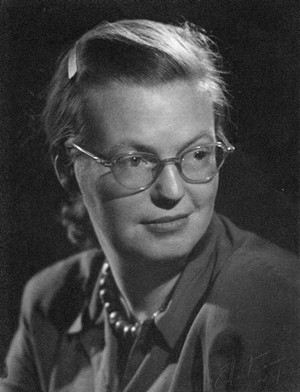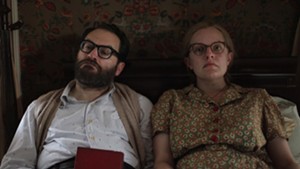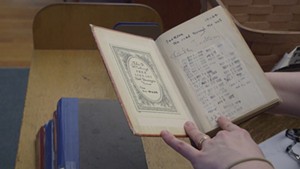
- Shirley Jackson Estate
- Shirley Jackson
On June 26, 1948, the New Yorker published a now-famous story about a fictional rural town. This unnamed village has a square between the post office and the bank; men "speaking of planting and rain, tractors and taxes"; and wives "wearing faded house dresses and sweaters" who share gossip. It has boisterous schoolchildren, a one-size-fits-all events officiant and a venerated Old Timer.
The town also has a tradition of choosing one person each year — by way of an old-fashioned lottery — to stone to death.
Overnight, "The Lottery" put its author, Shirley Jackson, on the literary map. And while her fictional town is presented as an insular, tradition-oriented Anytown, USA, the story was written in the small southern Vermont town of North Bennington.
Jackson and her husband, Stanley Edgar Hyman, moved to North Bennington in 1945, when Hyman took a teaching position at Bennington College. Or, as literary critic Paul Theroux wrote in his review of the collected Jackson works, Let Me Tell You, they "rusticated themselves." Jackson lived there until her death in 1965 at the age of 48. During her life, she produced many more short stories, memoirs and neo-gothic novels — one of which, The Haunting of Hill House, has twice been adapted by Hollywood. According to biographer Ruth Franklin, Stephen King considers it one of the greatest horror novels of all time.
Over the past decade, Jackson's reputation has gained considerable momentum worldwide, but traces of her legacy in North Bennington remain faint. Jackson's son Barry Hyman has lived close to the town for most of his life. "There's no plaque; there's really no concrete, official evidence of Shirley Jackson in North Bennington at all," he told Seven Days by phone, "and most of the people who knew her are gone."
According to Hyman, projects currently in the works related to Jackson or her writings include a movie, a TV series and a ballet. Jackson's grandson* Miles Hyman is at work on a graphic-novel version of "The Lottery." In the catalog for the Shelburne Museum's upcoming exhibition "Grandma Moses: American Modern," Stanford art historian Alexander Nemerov uses Jackson to frame his discussion of place and cultural inheritance.
The Shirley Jackson Estate, Barry Hyman said, earned more money in 2015 than any other year. (That estate is managed by his brother, Jackson's eldest child, Laurence Jackson Hyman, who lives in northern California.) "Her legacy is very strong worldwide," Hyman said.
In North Bennington, the most significant recognition happens on Shirley Jackson Day, an annual event organized by Tom Fels in which community members read from selections of the author's work. Fels' father was president of Bennington College when Jackson's husband taught there, and he grew up with the couple's children. In 2007, during an 11-year run as president of the Bennington Cultural and Arts Council, Fels decided to incorporate a small Jackson reading into the area's June arts festival. He was the primary reader.
Barry Hyman has worked closely with Fels in planning Shirley Jackson Day since its inception. Last year's gathering attracted about 25 people — the highest attendance to date, Hyman claimed. Among its readers was Franklin, whose highly anticipated biography Shirley Jackson: A Rather Haunted Life is due out in September.
This year, Hyman said, representatives from the Shirley Jackson Awards plan to attend. Established in 2007 by an independent group of writers and scholars, the awards honor published works that demonstrate "outstanding achievement in the literature of psychological suspense, horror and the dark fantastic."
The date Fels selected for Shirley Jackson Day is June 27 — the same one the author claimed for "The Lottery." The choice is deliciously poetic, since many have written and speculated about whether the short story was Jackson's personal retaliation against North Bennington. Some accounts — albeit contested — say that Jackson's family was the target of anti-Semitic harassment there.
Both during her life and retroactively, Jackson has been shrouded in the mystery typically accorded to witches. It probably didn't help that she authored the 1956 Landmark Books children's textbook The Witchcraft of Salem Village. A 1988 article by Elizabeth Frank in the New York Times was headlined "The Sorceress of Bennington," and a 2009 article by Joyce Carol Oates in the New York Review of Books was titled "The Witchcraft of Shirley Jackson."
For his part, Hyman asserted, "I think ["The Lottery" is] more a work of imagination than a thinly disguised autobiographical moment. [My mother] was very conscious of being different, but she worked very hard at being friendly and going to PTA meetings, being a Scout mother, going to Little League games."
In confirmation of that portrait, Jackson even wrote a play that was produced to support the local school's PTA, titled "All Aboard for Fun."
Over her brief lifetime, Jackson published six novels and dozens of short stories. Though these remain in print today, many still consider her output to be vastly underappreciated. In his introduction to the 2006 Penguin edition of Jackson's novel We Have Always Lived in the Castle, writer Jonathan Lethem refers to her as "one of American fiction's impossible presences ... hidden in plain sight." In 2010, journalist Laura Miller wrote for Salon, "The author of 'The Lottery' is still not getting the respect she deserves."
One strain of thought about Jackson's burgeoning revival relates to the emergence of contemporary feminism and feminist movements. "[My mother] died just as a coherent feminist movement was starting to congeal," noted Hyman. He said Franklin's forthcoming biography has been instrumental to his own reframing of his mother, particularly in "how often the feminist angle came up."
Jackson did not write exclusively, or even mostly, horror stories. Many of her darkest works were imbued with mundaneness and domesticity — often written from the point of view of what Oates labeled "isolated and estranged, hypersensitive young-woman protagonists." Jackson was versatile, though. Her memoirs Life Among the Savages and Raising Demons contain funny, often-cheerful accounts of motherhood, and she contributed many articles to popular women's magazines.
Perhaps part of the challenge of giving Jackson her place in literary history is that it requires reconciling her demons and her ordinariness — and realizing that the two can exist simultaneously. As Lethem writes, "She disinterred the wickedness in normality."
Just a few miles from North Bennington stands the Robert Frost Stone House Museum, which was founded by Carole Thompson in 2002. Thompson told Seven Days by phone that she receives 3,500 to 4,000 visitors from May through October. That figure contrasts starkly with the occasional fan or scholar who comes through town asking about Jackson. "[North Bennington has] such an opportunity [with Shirley Jackson], if somebody will just pick it up and go with it," said Thompson.
"We've bounced the idea around of some kind of museum," Hyman said, "but it's hard to think of any concrete or tangible structure that could be the centerpiece of Shirley Jackson's legacy in North Bennington."
Both of the homes where Jackson and her family lived are privately owned residences. Biographer Franklin wrote in an email that, in addition to these, inquisitive visitors can see "Powers Market, where Jackson shopped, [and] the Everett Mansion [a historic building on the campus of Southern Vermont College] and its spooky grounds ... That's pretty much it for the Shirley Jackson walking tour."
[image-3]In addition, the public library has a handful of signed volumes, as well as a life-size ceramic cat that once belonged to Jackson with a note taped to the bottom explaining its provenance. But, unlike her popular predecessor Robert Frost, Jackson is not buried in the area; she was cremated, her ashes scattered in various locations, according to Hyman.
"I think, for a long time, people in North Bennington thought, Oh, yeah, some writer lived here. So what? There's lots of writers," Hyman suggested.
The jury is still out on whether the town will rally behind its most famous former resident and give literary tourists something to grasp. But, as Fels put it, "There's definitely a Shirley Jackson world out there."
*Correction, June 29, 2016: An earlier version of this story misidentified Miles Hyman's relation to Shirley Jackson.











Comments
Comments are closed.
From 2014-2020, Seven Days allowed readers to comment on all stories posted on our website. While we've appreciated the suggestions and insights, right now Seven Days is prioritizing our core mission — producing high-quality, responsible local journalism — over moderating online debates between readers.
To criticize, correct or praise our reporting, please send us a letter to the editor or send us a tip. We’ll check it out and report the results.
Online comments may return when we have better tech tools for managing them. Thanks for reading.